You’re staring at your green pool, wondering how to clean it up fast. Don’t worry, you’re in the right place! This guide will give you all the quick and efficient methods to tackle that algae invasion.
Ready to turn your pool from green to clean? Let’s dive in!
Article Contents
Steps to Clean a Green Pool (Guaranteed Fast)
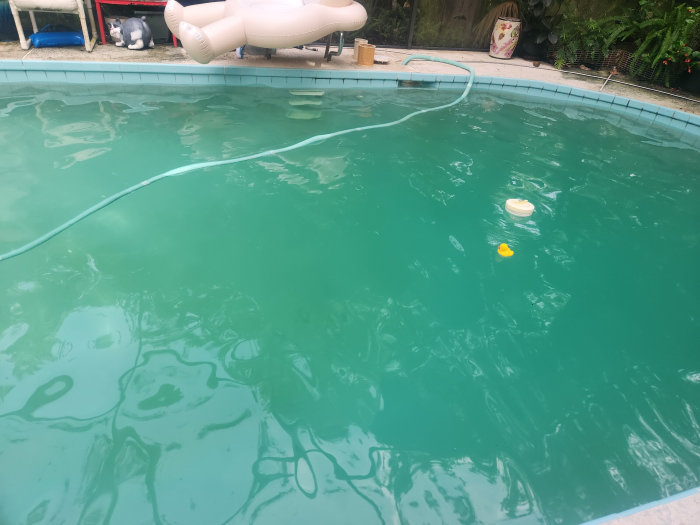
From cleaning the filter to shocking the pool, we’ll guide you through this process to ensure quick and effective results.
1. Clean the Filter
You’ll need to thoroughly clean your pool’s filter as a crucial step in restoring your green pool to its sparkling, healthy state. The filter will likely be blocked up with algae.
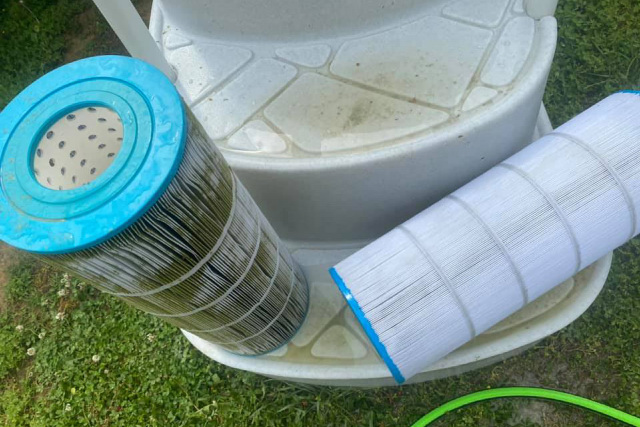
Sand and DE Filters need backwashing to clean them. Hose cartridge filters to clean them or soak in a weak muriatic acid solution for a deep clean.
2. Brush Pool Walls and Floor
After cleaning the filter, it’s time thoroughly brush the walls and floor to dislodge any stubborn algae. Using a pool brush, start at the shallow end, working your way toward the deep end. Make sure to brush pool walls and floor vigorously, paying extra attention to corners and crevices where algae tend to hide.
This is a critical step to clean a green pool fast and effectively. Remember, the goal is to get the algae into suspension in the water so it can be killed by the chlorine.
3. Test the Water & Adjust
Once your pool’s walls and floor have been thoroughly brushed, it’s time to test the water and adjust the pH, stabilizer (cyanuric acid) and alkalinity levels, if necessary.
- Test your water: Use a reliable pool test kit to measure the pH, alkalinity, stabilizer and chlorine levels.
- Interpret the results: A balanced pool should have a pH between 7.2 and 7.6, alkalinity between 80 and 120 ppm and stabilizer between 30 and 60 ppm.
- Adjust & Retest: If levels are off, adjust them and retest.
Note: if the pH and stabilizer levels are off, it will be difficult to clear your green pool.
4. Shock the pool (super chlorinate)
The next step in cleaning your green pool quickly is to shock it, also known as super chlorination, to effectively kill algae and clear the water.
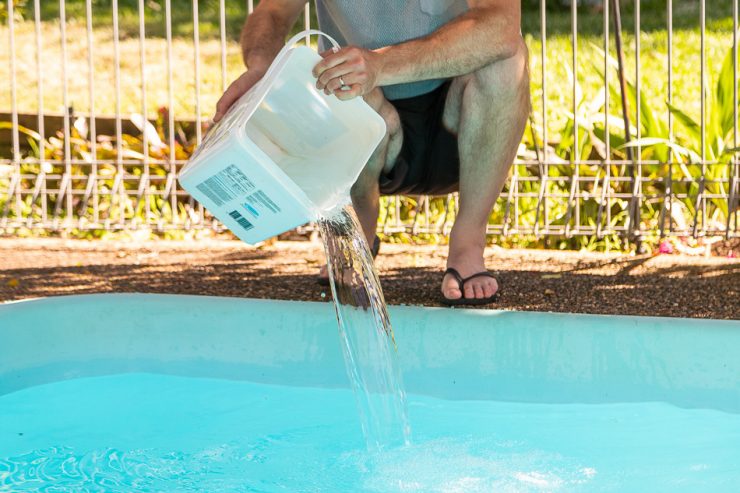
To shock the pool, use “pool shock” or calcium hypochlorite (cal-hypo) chlorine. Follow the manufacturer’s instructions for the amount. Usually dose is 1 lb (0.45 kg) of for every 10,000 gallons (37,854 L) of pool water. Dissolve the shock in a bucket of water and then add it to your pool, distributing it evenly.
5. Filter for 12 hrs and Retest
Start running your pool’s filter for at least 12 hours, allowing the chlorine to circulate and further eliminate any remaining algae.
If your pool is still green, don’t fret.
6. Repeat Until Algae is Gone
After filtering for 12 hours, take a look at the water. Dead algae usually turns gray or white, which is a good sign. However, don’t stop your pool care routine at this point.
You’ll need to repeat this process until all algae is completely gone. It can take several days if your pool is dark green with algae. For lightly cloudy water or light green, it may only take one treatment.
When the algae is dead, you’ll need to vacuum the pool thoroughly too. And clean the filter yet again.
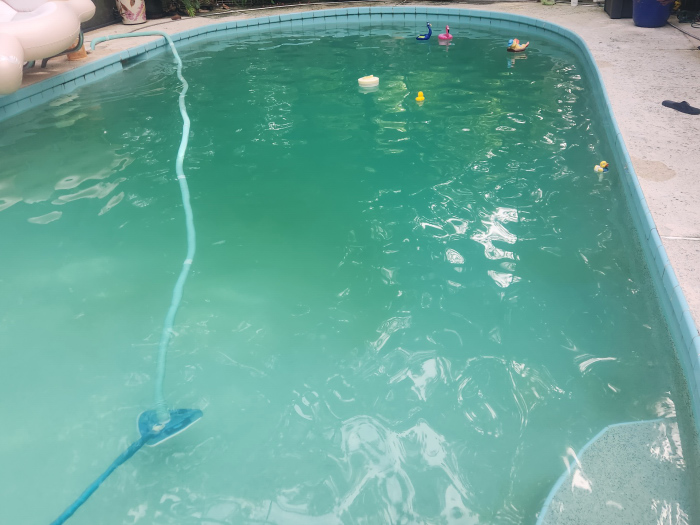
The whole process may seem tedious, but trust me, it’s worth it. The key is consistency, regularly checking your pool, and adjusting your pool care plan as needed.
Cleaning a Green Saltwater Pool with Chlorine
If you’re dealing with a green saltwater pool, the process is the same. The only difference is that you will turn up your saltwater chlorine generator (chlorinator) to 100% power.
It’s also worth checking the condition of the salt cell to ensure it’s working properly. You may need to clean the cell.
Dealing with Recurring Green Pool Problems
Most often, recurring green pool water is a result of improper maintenance. Algae growth is caused by lack of chlorine and/or high levels of cyanuric acid. Poor water circulation, inadequate filtration, or improper chemical balance can also cause the problem.
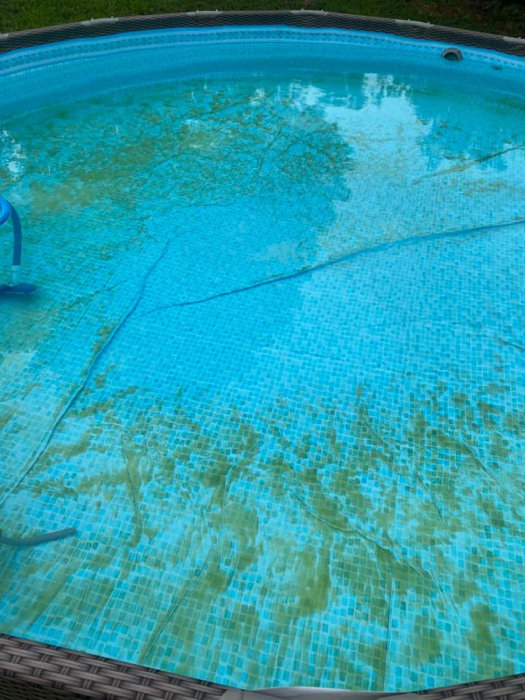
To tackle this problem, first make sure stabilizer (cyanuric acid) is between 30 and 60 ppm. If it is above 80 ppm, consider adding fresh water to your pool to dilute it. Next get the pH to the correct level. It should be 7.2 to 7.6.
Now you can shock. Shock the pool with a high dose of chlorine (free chlorine should be around 10-15 ppm) to kill the existing algae.
Additionally, using algaecides can help keep the water crystal clear. Patience and persistence are key to resolving persistent green pool problems.
Understanding Green Pool Causes
So why did your pool turn green to start with?
Algae Growth Factors
While you’re battling algae in your pool, it’s crucial to understand the factors that contribute to its growth so you can prevent it from turning green again.
- Nutrient Levels: High levels of phosphates and nitrates are algae growth factors that turn your pool water green. Regular testing helps maintain balance.
- Poor Circulation: Stagnant water encourages green algae. Ensure your pool’s pump and filter system are functioning properly.
- Insufficient Sanitation: Improper chlorine levels make your pool a prime breeding ground for pool algae. Maintain proper sanitation to keep your pool crystal clear.
- Sunlight: Algae love sunlight. Using a pool cover when the pool isn’t in use can help prevent algae growth.
Insufficient Chlorine
The most common cause of your pool turning green is insufficient chlorine levels. This imbalance of pool chemicals allows the algae to thrive, turning your swimming pool into a murky, green mess.
To clean a green pool fast, it’s crucial to first kill the algae by shocking, then you need to maintain the correct chlorine levels (between 3-4 ppm)
But remember, it’s not a one-time job. Regular testing and adjusting of chlorine levels is key to maintaining a sparkling, algae-free pool. So, don’t let insufficient chlorine turn your pool green.
Importance of Pool Maintenance
Regular pool maintenance is your best defense against green pool problems, as it helps address the root causes of algae issues. Here are four key steps to keep your pool clean and clear:
- Regular Testing: Test your pool’s pH and chlorine levels at least twice a week. It’s crucial to maintain proper balance.
- Consistent Cleaning: Vacuum and skim your pool weekly. Don’t forget the pool filter; a clean filter enhances water circulation and filtration.
- Shock Treatment: Use shock treatments as needed, especially after heavy use or heavy rain, to quickly raise the chlorine level.
Green Pool FAQs
Why is My Pool Still Green After Shocking
Despite adding shock to your pool, it’s still looking green. You’re probably wondering, ‘why is my pool still green after shocking?’.
Here’s why your pool is still green:
- Insufficient Shock Dosage: This is the most common reason. You haven’t used enough shock. You need to super chlorinate the pool, which means a double or triple dose of chlorine shock. You may also need to repeat this for several days.
- Poor Circulation: Your pool’s filtration system mightn’t be functioning properly, leaving parts of your pool untreated.
- Imbalanced Chemicals: Other chemical imbalances can cause your pool to remain green, even after shocking. Check the pH and stabilizer levels are correct.
Keep these points in mind the next time you shock your pool.
How Long Does it Take to Clear a Green Pool
The time it takes to clear a green pool depends on the severity of the algae infestation and your methods of cleaning. It can take anywhere from 24 hours to several days. If you’re wondering how speed up the cleaning process, you’ll need to use a strong pool shock and keep on it.
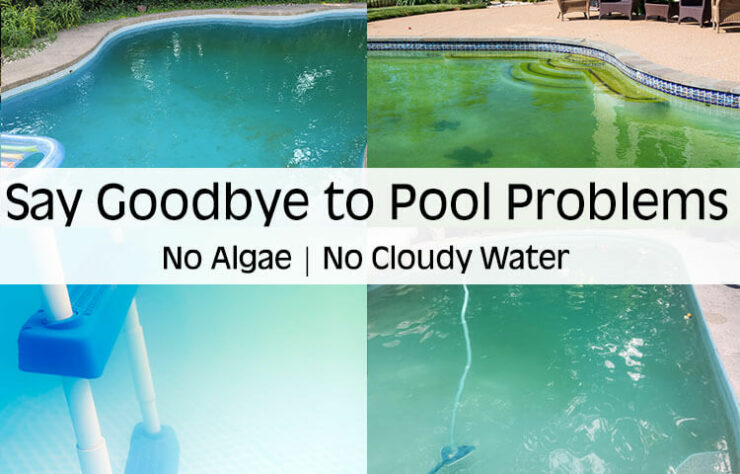
You can expect to see significant improvements in your green pool water within 24-48 hours of the shock treatment. However, don’t rush the process. It’s essential to maintain your clean pool by testing and adjusting the water chemistry regularly.
Patience and consistency are key in tackling a green pool.
Does Baking Soda Clean a Green Pool
Let’s tackle the often misunderstood role of baking soda: does it actually clean a green pool? The short answer is no, but let’s dive in a bit deeper.
- Understanding the Problem: Green pool water is usually caused by algae. Baking soda doesn’t kill algae, it only adjusts your pool’s pH and alkalinity levels.
- The True Cleaning Agent: To clean a green pool, you’ll need chlorine to kill the algae.
- Baking Soda’s Role: While baking soda won’t fix green pool water, it can help adjust the pH to the correct level. Chlorine needs the correct pH to have maximum impact.
- Preventive Measures: Regular maintenance and monitoring can prevent conditions that turn your water green.
Should You Use Clarifier or Shock?
Clarifier can be helpful to clear up cloudy water quickly, once you’ve killed the algae. Clarifiers work by binding small particles into larger ones for easier filtering. However, it’s not enough to treat green pool water on its own.
You’ll need to shock a pool to kill the algae that’s turning your water green.
Maintenance Tips to Avoid a Green Pool Water
- Test and adjust the water chemistry regularly: This includes pH, alkalinity, and chlorine levels.
- Clean your pool regularly: Regular brushing and vacuuming keep algae at bay.
- Run your filter for the right duration: This ensures the water is well circulated, helping to prevent algae growth.
- Cover your pool when not in use: This prevents debris and sunlight, which can foster algae growth.
Summary
So, there you have it! The one key takeaway to cleaning a green pool quickly is add chlorine and add lots of it. If you do that, you’ll have clear pool water in no time.

